Plan checklist
The Belsey Property
500 Bayshore Boulevard, Lake Vernon
Planting plan created by The District Municipality of Muskoka
Funded by •


Schedule A:
Plants & Property
Land Characteristics
This planting plan is designed based on the land characteristics identified during the day of the site visit. Plants are chosen according to the soil and light conditions on your property. The number of plants chosen for each planting compartment takes into account the square metre area of the space, as well as the amount of current vegetation cover. Your property is part of ecoZone: 4b
Land Characteristics by Compartment
| Length | Width | Area | pH | Soil | Moisture | Light | Height | |
|---|---|---|---|---|---|---|---|---|
| A | 6m | 3.2m | 9.6m2 | acidic | loamy, clay | normal, moist | full sun | |
| B | 8m | 4m | 32m2 | acidic | loamy, clay | normal, moist | full sun | max 2m |
| C | 4.5m | 3m | 13.5m2 | acidic | loamy, clay | normal, moist | full sun | max 2m |
| D | 2.5m | 3m | 7.5m2 | acidic | loamy, clay | normal | full sun | |
| E | 5m | 20m | 100m2 | basic | sandy, loamy | normal | partial sun | |
| 26m | 6.64m | 162.6m2 |
Plant Selection Summary
The following shrubs and trees are chosen for their suitability and survivability given the current soil and light conditions in each compartment on your property, as well as preferable features.
| Plant Species | A | B | C | D | E | Potted | Bareroot | Wildflower |
|---|---|---|---|---|---|---|---|---|
| Buttonbush | 1 | 1 | ||||||
| Sweet Gale | 1 | 1 | ||||||
| Narrow Leaved Meadowsweet | 3 | 4 | 6 | 13 | ||||
| Shining Willow | 1 | 1 | ||||||
| Blue Flag Iris | 4 | 4 | ||||||
| Royal Fern | 4 | 4 | ||||||
| Spotted Joe-Pye Weed | 3 | 3 | ||||||
| Blue Vervain | 3 | 3 | ||||||
| White Turtlehead | 3 | 3 | ||||||
| Bush Honeysuckle | 5 | 6 | 9 | 20 | ||||
| Ninebark | 1 | 1 | 2 | |||||
| Kalm St. Johns Wort | 4 | 6 | 10 | |||||
| Sweet Fern | 3 | 3 | ||||||
| Red Osier Dogwood | 1 | 1 | 2 | |||||
| Oswego Tea (Red Bergamot) | 5 | 5 | ||||||
| Wild Bergamot | 5 | 5 | ||||||
| Switchgrass | 6 | 6 | ||||||
| Black Chokeberry | 1 | 1 | ||||||
| Indian Grass | 4 | 4 | ||||||
| Sensitive Fern | 9 | 9 | ||||||
| Winterberry Holly | 5 | 5 | ||||||
| Ostrich Fern | 5 | 9 | 14 | |||||
| Snowberry | 6 | 6 | ||||||
| Fragrant Sumac | 6 | 6 | ||||||
| Bearberry | 10 | 10 | ||||||
| Subtotal | 23 | 34 | 33 | 11 | 40 | 71 | 0 | 70 |
| Totals | 141 | |||||||
Plant Information
The following table summarizes key information about each plant selected for your property.
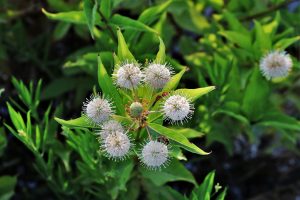
|
ButtonbushHeight: 2 m
Buttonbush is a small to medium-sized deciduous shrub species which typically grows about 2 m in height. This plant may also be known by the common name Button Willow. Twigs are slender to stout and dark red-brown in colour with white speckling. The leaves are bright green coloured, shiny, ovate shaped, oppositely arranged, and have entire margins. The flowers are tiny, tubular, white, fragrant, and appear densely on distinctive, spherical clusters in June. These flowers turn into a dense cluster of seeds, which remain on the plant throughout the winter. The flowers are beneficial for pollinator species, including hummingbirds and butterflies. This is a hardy, adaptable species and an excellent choice for planting on wet shoreline sites.
|
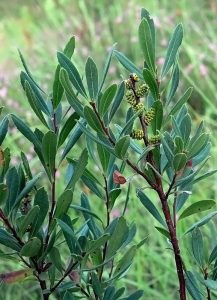
|
Sweet GaleHeight: 1-2m
Sweet Gale is a medium-sized shrub which grows into a thick bush about 1-2 m tall. This species produces 1-8 cm long, oblong-lanceolate leaves which are finely toothed at the tip and are spirally arranged. When bruised, these leaves give off a pleasant aroma. Male and female catkins are produced on separate plants. The seeds are dispersed from the female plants via water, as they float on two corky bracts. This shrub also provides a good food source for bird species that eat the seeds including Grouse, Chickadees, and Bluebirds. Mammal species like Beavers and White-Tailed Deer also browse on the twigs and leaves of this plant.
|
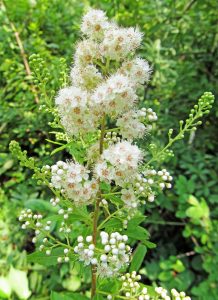
|
Narrow Leaved MeadowsweetHeight: 1-2m
The Narrow Leaved Meadowsweet is an erect, deciduous shrub, which grows in the shape of a mound to a height of 1-2m. This species develops numerous branches and branchlets, giving it a sparse appearance. Leaves produced are simple and narrow with sharply toothed borders growing alternately along the branches. These bright, light green leaves appear crowded, as they grow close together on the stocks and branches. During the fall, leaves turn a yellow-red or yellow-orange colour. Small white to light pink flower clusters appear in the spring growing in a dense, narrow pyramid at the terminal ends of the branches. During late summer to early fall, these flowers produce smooth, papery seed pods.
|
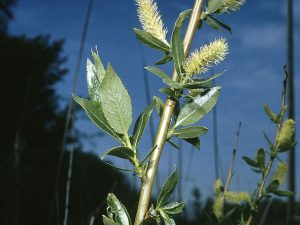
|
Shining WillowHeight: 10m
The Shining Willow is a relatively large deciduous shrub, which grows up to 10 m in height. The shiny leaves are 5-11 cm long and 1-5 cm wide, which are what give this Willow its name. They are lance shaped, with dark green color on the top, and light green on the bottom. Flowers bloom from May to June and range in colour from yellow to a green/brown.
|
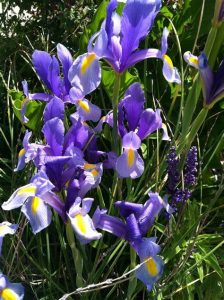
|
Blue Flag IrisHeight: 0.5 m
The Blue Flag Iris is a showy perennial wildflower that typically grows about 0.5 m in height. This plant may also be known by the common name Harlequin Blue Flag. The leaves are light green, sword-shaped, slightly arched or erect, and appear growing out as a cluster around the base of the plant. The attractive blue flowers start to bloom in the early spring, emerging from a tall flowering stalk that can reach up to 1 m. The flowers are beneficial to pollinator species, like bees and butterflies. The seeds are also beneficial to wildlife species, like birds and small mammals.
|
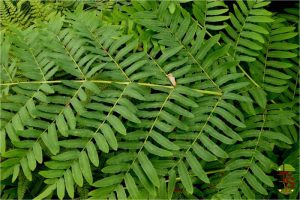
|
Royal FernHeight: 1 m
Royal Fern is a perennial fern species that typically grows less than 1 m in height. This plant may also be known by the common name Flowering Fern. Fiddleheads appear from the base of the plant and unfurl into green, arching, pinnately compound leaves. The leaves of this fern are well separated, broader, and more rounded than other ferns, giving it the appearance of a pea plant. Erect, spore-bearing fronds grow out of the center of the leaves in the early spring and turn brown in the fall. The fronds of this fern have a flower like appearance.
|
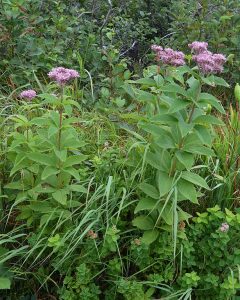
|
Spotted Joe-Pye WeedHeight: 1.5 m
Spotted Joe-Pye Weed is a colourful wildflower species that can grow up to 1.5 m tall and can spread about 1 m. It has a plain or spotted purple stem, which is sometimes covered in fine hairs. The leaves are large, lanceolate shaped, have serrated edges, and appear in whorls of 3-5. The flowers are showy, fragrant, bright pink/purple coloured, have 8-20 disk florets, appear in clusters at the top of a flowering stem, and bloom in mid to late summer. The flowers are beneficial to pollinator species, like bees and butterflies. This plant spreads well and can form small colonies. The roots can be useful for controlling erosion and stabilizing shorelines.
|
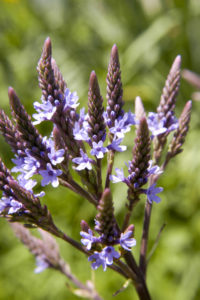
|
Blue VervainHeight: 1.5 m
Blue Vervain is a perennial wildflower species that grows about 1.5 m in height. It has a slender, upright form with reddish-green coloured, rough-haired stems. Its leaves are oppositely arranged, lance-shaped, and on short petioles with large serrations along the edge. Occasionally, there are two lobes present at the base of the leaves. The flowers are showy, blueish purple coloured, have five petals, appear on dense spikes at the top of flowering stems, and bloom between July and September. The flowers bloom first at the bottom of the spike, travelling upwards and blooming in bands. This plant spreads well and can form small colonies. The flowers are beneficial to pollinator species, like bees and butterflies. The seeds are also beneficial to wildlife species, like birds and small mammals.
|
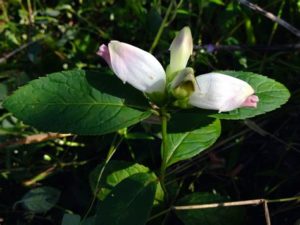
|
White TurtleheadHeight: 1 m
White Turtlehead is a beautiful wildflower species that can grow up to 1 m in height and spreads about 0.5 m. The leaves are oppositely arranged, dark green coloured, short-stalked, lance-shaped, and have sharply toothed margins. The flowers are whitish pink coloured, shaped like a turtle's head, made of two lips creating a tube, appear in dense spikes at the tip of erect stems, and bloom between August and October. The flowers are beneficial to pollinator species, like bees and butterflies.
|
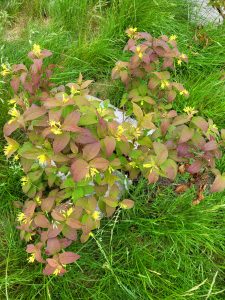
|
Bush HoneysuckleHeight: 1m
The Bush Honeysuckle is a small, hardy, deciduous shrub that rarely grows taller than 1 m in height. The leaves are simple, oppositely arranged, ovate shaped, and have finely toothed margins. During the spring and summer, the leaves are dark green in colour, then in the fall they take on a variety of colours ranging from a deep purple to light yellow. The flowers are small, showy, yellow to orange colored, trumpet shaped, appear in clusters on the tips of branches, and bloom between June and July. The flowers are beneficial to pollinator species, including hummingbirds and butterflies. The roots of the Bush Honeysuckle are fibrous, giving it the ability to form thickets and making it an ideal shrub to plant for erosion control.
|
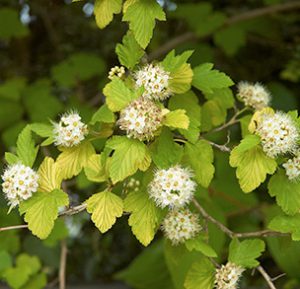
|
NinebarkHeight: 2-3m
The Common Ninebark is a very hardy, large (2-3m in height), deciduous shrub naturally occurring within riparian zones. This species is often planted as an ornamental shrub for its exfoliating bark which reveals reddish-light brown inner bark. This shrub is multi-stemmed with numerous horizontal and ascending branches creating a full, round shape. The Common Ninebark produces dull green, ovate to round shaped leaves with three to five lobes per leaf. During the fall the leaves turn brilliant yellow or dark purple. Between May and June, showy, bell-shaped flowers bloom in clusters on the terminal ends of the branches. During the summer, these flowers give way to small green or green-yellow berries which turn a bright red upon ripening.
|
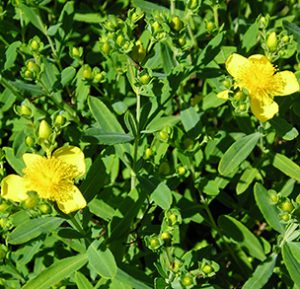
|
Kalm St. Johns WortHeight: 1 m
Kalm St. Johns Wort is a short, evergreen shrub species that typically grows less than 1 m in height. Older bark is reddish brown and appears shedding. The leaves are bluish green colored, narrow and linear shaped, appear in oppositely arranged pairs, and have entire margins. The flowers are showy, golden yellow colored, have five petals, numerous stamens, appear on upper branching stems, and bloom between July and August. These flowers produce small brown oval seed capsules. The flowers are beneficial for pollinator species, like bees and butterflies. These shrubs are visually attractive and used for making low hedges.
|
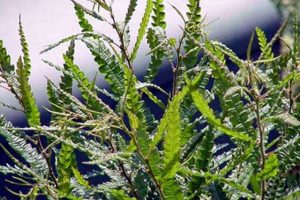
|
Sweet FernHeight: 1 m
Sweet Fern is a deciduous shrub species that typically grows 1 m in height. The leaves are dark green coloured, alternately arranged, narrow, lance shaped, have entire margins, rounded lobes, and are deeply notched, giving the appearance of a fern. The leaves are also aromatic when rubbed or crushed. The flowers are small, yellowish green catkins, which bloom between May and June. The fruits are greenish brown, burr like nutlets. This plant fixes it’s own nitrogen, which allows it to grow in poor soil and benefit nearby plants. This plant spreads well to produce small colonies. It is useful for controlling erosion and stabilizing shorelines.
|
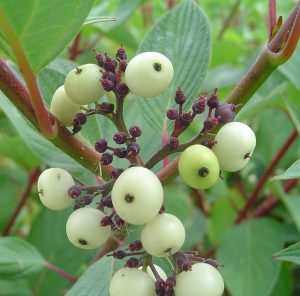
|
Red Osier DogwoodHeight: 1.5-4m
The Red Osier Dogwood is a medium-sized, deciduous shrub native throughout Northern and Western North America which typically grows to 1.5-4m. This species is multi-stemmed with numerous erect and ascending bright red branches that create a loose and spreading form. Leaves produced are simple, two-toned with a dark green upper side and light green underside. They are arranged opposite each other along the branches. During the fall, the foliage turns a brilliant red to dark purple. Clusters of small, creamy white flowers form on the terminal ends of the branches between June and July. The Red Osier Dogwood produces blueish-white fruiting bodies during late summer, which may persist throughout the winter. This shrub's berries provide an important winter food source for numerous species, from large deer to small wintering birds.
|
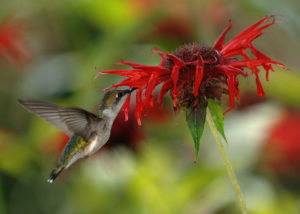
|
Oswego Tea (Red Bergamot)Height: 50 cm
Oswego Tea is a showy perennial wildflower species that typically grows about 50 cm in height. This plant may also be known by the common names Red Bergamot or Scarlet Beebalm. The leaves are dark green, oval shaped, have a minty fragrance. The unique flowers are bright red and grow in dense rounded clusters, with individual tubular flowers that bloom between May and October. The beautiful flowers of Oswego Tea attract various pollinator species like hummingbirds, butterflies, and bees. The Oswego Tea plant is susceptible to a common fungal disease, called powdery mildew, when planted in dry soils. Historically, the leaves of the plant have been used for antiseptic purposes, as well as poultices to heal minor wounds and skin infections.
|
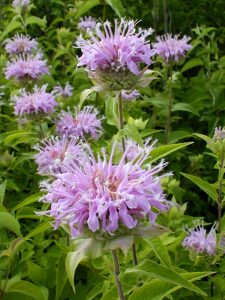
|
Wild BergamotHeight: 1 m
Wild Bergamot is a perennial wildflower species that is member of the mint family and can grow about 1 m tall. Its stems are light green and smooth with abundant branching on the upper half. The leaves are oppositely arranged, broadly lanceolate shaped, 6-10 cm long, and have toothed edges. The also leaves emit a aromatic minty/oregano scent when crushed. The flowers are showy, pink/lavender coloured, appear on the ends of flowering stems, and bloom between July and September. The flowers bloom in the center of the head first, moving outwards creating a wreath. The flowers are beneficial to pollinator species, like bees and butterflies. This wildflower spreads well and can be used to naturalize un-vegetated areas. The roots can be useful for controlling erosion and stabilizing shorelines.
|
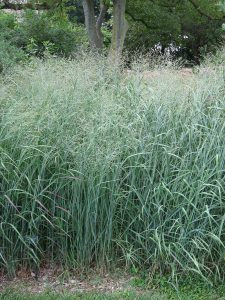
|
SwitchgrassHeight: 1.5 m
Switch Grass is a perennial, ornamental grass species that typically grows about 1.5 m in height. This plant may also be known by the common name Panic Grass. The leaves are blueish green, flat and erect, change yellow in the fall, change tan in the winter, and appear in basal clumps. The flowers are airy panicles with purplish pink tinges, appear on wide spreading spikelets off tall flower stems, and bloom between August and September. Switch Grass is easy to grow and is low maintenance. This plant spreads well and can form small colonies. The roots can be useful for controlling erosion and stabilizing shorelines. The seeds are also beneficial to wildlife species, like birds and small mammals.
|
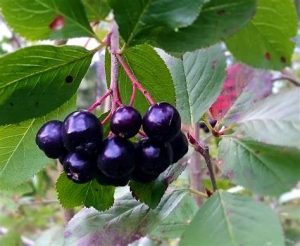
|
Black ChokeberryHeight: 1-3m
The Black Chokeberry is a medium sized deciduous shrub that typically grows between 1-3m with edible fruit. This species requires full sun to partial shade and can tolerate soil conditions from loamy and moist to rocky and dry. Naturally, Black Chokeberry is found in wet wooded areas such as; swamps, along shorelines, and within forest understory. This species is multi-stemmed, and forms thickets from stems which arise from the roots. Leaves are simple, growing alternately along the branch turning a bold red to orange during the fall. During spring, clusters of showy, white flowers appear turning into dark purple berries by fall. This species is resistant to drought, insects, pollution, and disease. The Black Chokeberry is often cultivated as an ornamental plant and food product. Additionally, this species is useful for bank stabilization and erosion control applications.
|
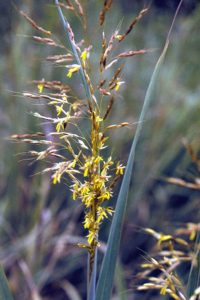
|
Indian GrassHeight: 1.5 m
Indian Grass is a perennial, ornamental grass species that can grow up to 1.5 m in height. The leaves are upright, slender, blueish green coloured, and change an orange yellow colour in the fall. The flowers are narrow, feathery, have an attractive reddish brown colour with yellow parts, and bloom between August to October. Indian Grass is easy to grow and is low maintenance. This plant spreads well and can form small colonies. The roots can useful for controlling erosion and stabilizing shorelines. The seeds are also beneficial to wildlife species, like birds and small mammals.
|
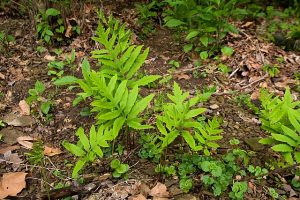
|
Sensitive FernHeight: 1 m
Sensitive Fern is a perennial fern species that typically grows less than 1 m in height. The leaves of this fern are light green, narrow, spaced out, have descending lower leaflets, and ascending upper leaflets. Erect, spore-bearing fronds appear out of the center of the leaves in the early spring and turn brown in the late summer. The fronds of this fern have a woody, segmented bead appearance.
|
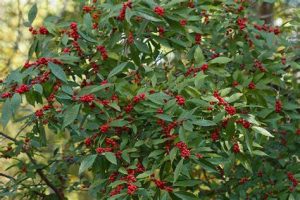
|
Winterberry HollyHeight: 3 m
Winterberry is a deciduous shrub species that typically grows about 3 m in height. The leaves are dark green coloured, alternately arranged, and have toothed margins. The flowers are small, greenish white coloured, not showy, and bloom between June and July. The fruits are attractive, bright red berries, which are not edible, only grow on female plants nearby male plants, and persist throughout the winter, hence the name. This plant spreads well and can form small colonies. The roots can useful for controlling erosion and stabilizing shorelines. The berries are highly beneficial to wildlife species, like birds and small mammals, throughout the winter.
|
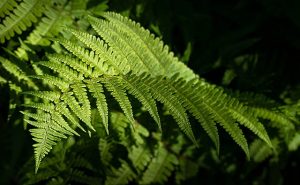
|
Ostrich FernHeight: 1.5 m
The Ostrich Fern is a coarse, erect to arching perennial fern, that can grow up to 1.5 m in height. The stems are clustered and arching while the leaves are ostrich-plume shaped, widest near top, and very gradually narrowed to the base. The size of the leaves grow up to 1.5 m long and 12-40 cm wide, with around 40 pairs of leaflets or pinnae. The leaflets are long, narrow-pointed, and ascending. The leaves are fertile, with spore clusters on the undersides of sub-leaflets.
|
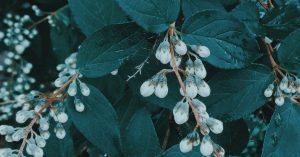
|
SnowberryHeight: 1-2m
The Snowberry is a small shrub known for its white berries bunching at the nodes. This species produces oval-shaped, oppositely arranged, dark green colored leaves with smooth margins on short stalks. The shrub grows 1-2m in height. This shrub yields white to pink clusters of bell-shaped flowers during the summer. The fruiting bodies produced by this shrub are small, white berries that grow in bunches. These berries provide a good food source to a variety of animals, but are poisonous to humans. Snowberry is an ideal species for bank stabilization applications because its roots are vigorous and deep ranging. .
|
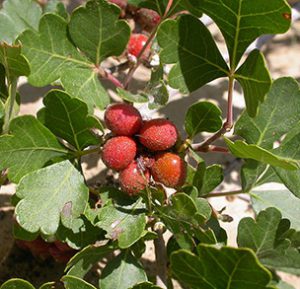
|
Fragrant SumacHeight: 1-2m
The Fragrant Sumac is a medium-sized deciduous shrub within the Cashew family. This species grows between 1-2 meters in height, is multi-stemmed, and produces a round, dense crown composed of erect and spreading branches. Between March and April, small yellow flower clusters bloom on the terminal ends of the branches prior to leaf development. Fruit development begins during late summer. Small, red, hairy berries are produced and can remain on the plant throughout the winter. Male catkins develop on the plant in September. Fragrant Sumac leaves are simple and arranged alternately along the branch. Leaves produced are simple and trifoliate with a large center lobe, appearing similar to Poison Ivy. During the spring and summer, the leaves are light green to green-yellow in colour turning a bright yellow to red or dark purple in autumn. Crushed leaves and stems of the Fragrant Sumac produce a fragrant citrus aroma, hence the common name. The aroma of this shrub is attractive to butterfly species, making it the perfect addition to any butterfly garden. The roots of the Fragrant Sumac are shallow, fibrous, and spread rapidly, making it an ideal choice for stabilizing shorelines and mitigating erosion on steep slopes. Unlike other Sumac species, Fragrant Sumac is significantly less aggressive and easily maintained.
|
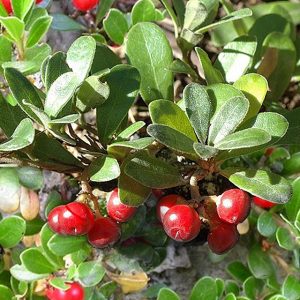
|
BearberryHeight: 20 cm
Bearberry is a low growing, evergreen shrub/ground cover species that grows about 20 cm tall. The leaves are dark green, leathery, shiny, ovate shaped, alternately arranged, and have entire margins. The flowers are tiny, urn shaped, white to pink colored, appear in drooping clusters, and bloom between April and May. Flowers are followed by bright red berries, which remain throughout the fall and winter. These berries are beneficial to wildlife species like birds and small mammals.
|
Compartment A
Naturalization Area
 pH: acidic
pH: acidic Depth: potted
Depth: potted-
 Moisture: normal, moist
Moisture: normal, moist -
 Soil Type: loamy, clay
Soil Type: loamy, clay -
 Light conditions: full sun
Light conditions: full sun
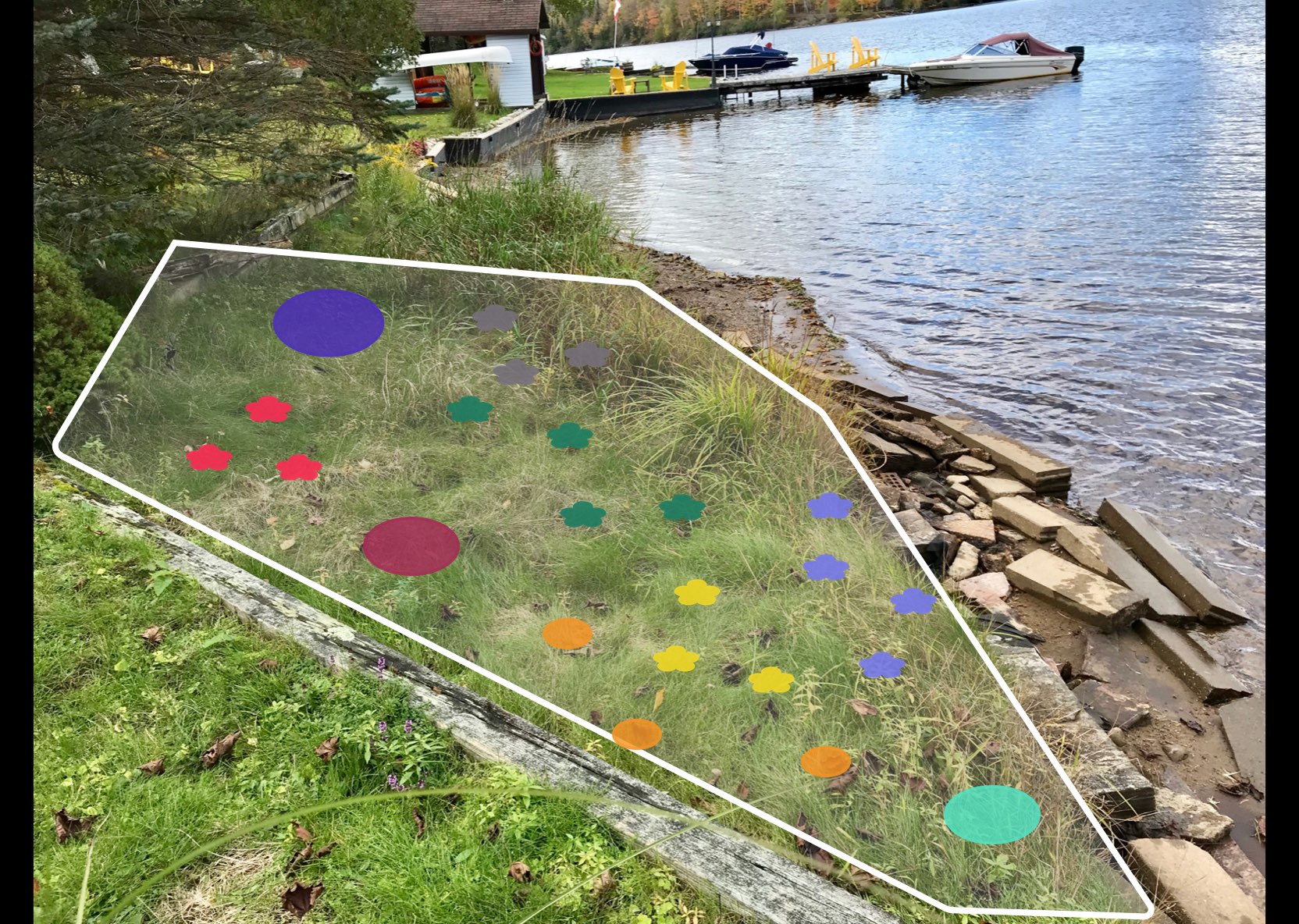
Compartment B
Naturalization Area
 pH: acidic
pH: acidic Depth: potted
Depth: potted-
 Moisture: normal, moist
Moisture: normal, moist -
 Soil Type: loamy, clay
Soil Type: loamy, clay  Plant Height: max 2m
Plant Height: max 2m-
 Light conditions: full sun
Light conditions: full sun
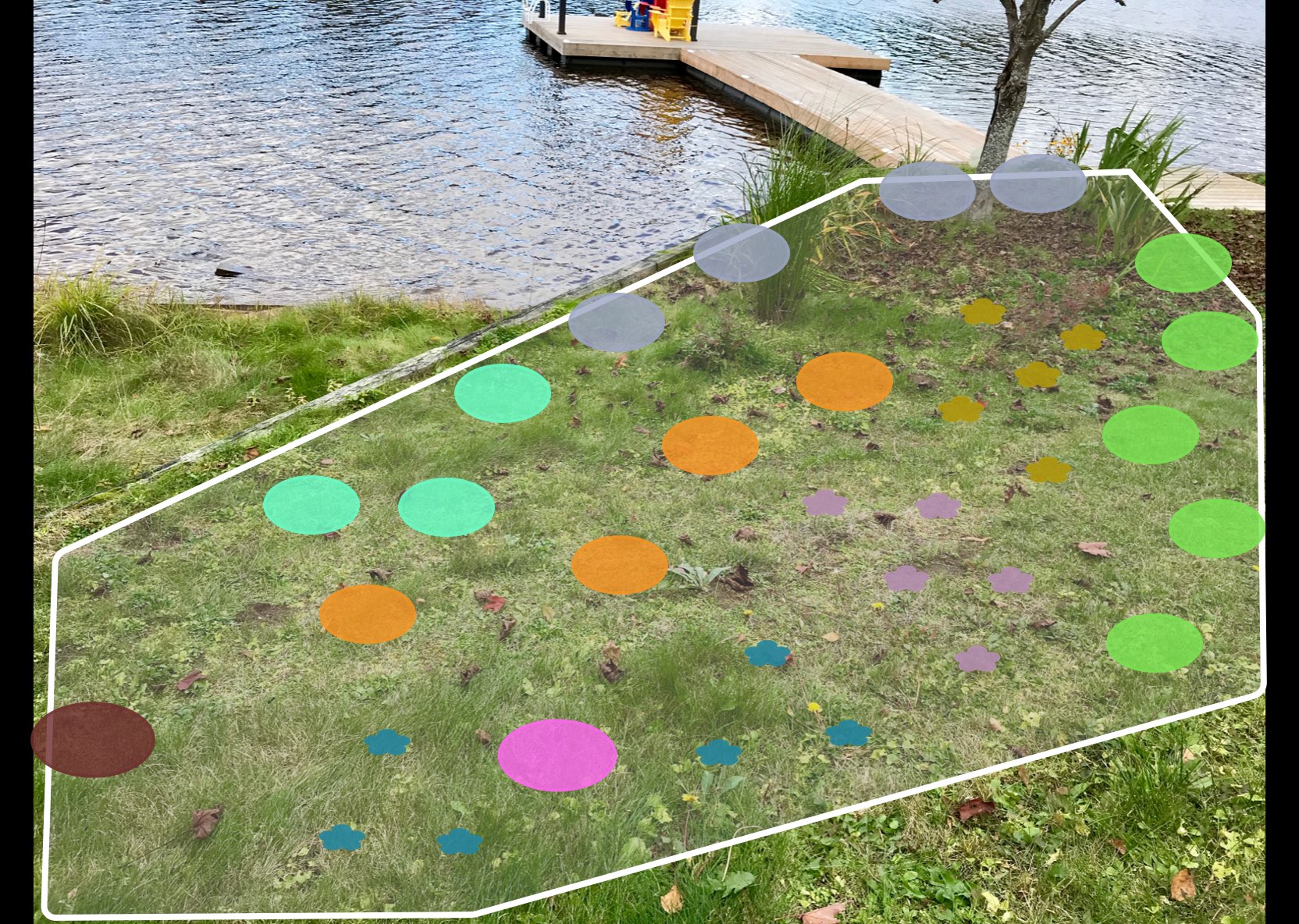
Compartment C
Naturalization Area
 pH: acidic
pH: acidic Depth: potted
Depth: potted-
 Moisture: normal, moist
Moisture: normal, moist -
 Soil Type: loamy, clay
Soil Type: loamy, clay  Plant Height: max 2m
Plant Height: max 2m-
 Light conditions: full sun
Light conditions: full sun
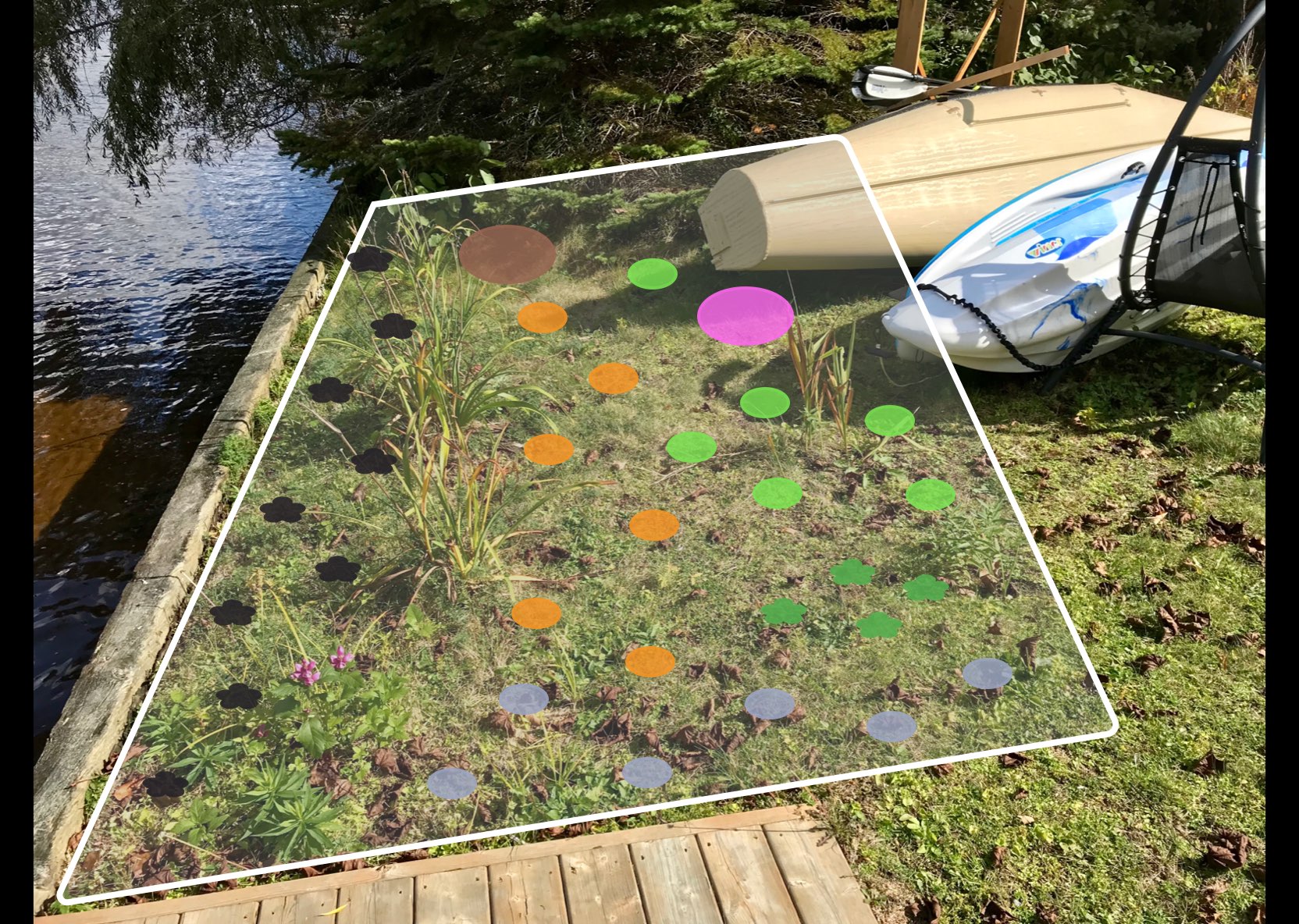
Compartment D
Naturalization Area
 pH: acidic
pH: acidic Depth: potted
Depth: potted-
 Moisture: normal
Moisture: normal -
 Soil Type: loamy, clay
Soil Type: loamy, clay -
 Light conditions: full sun
Light conditions: full sun
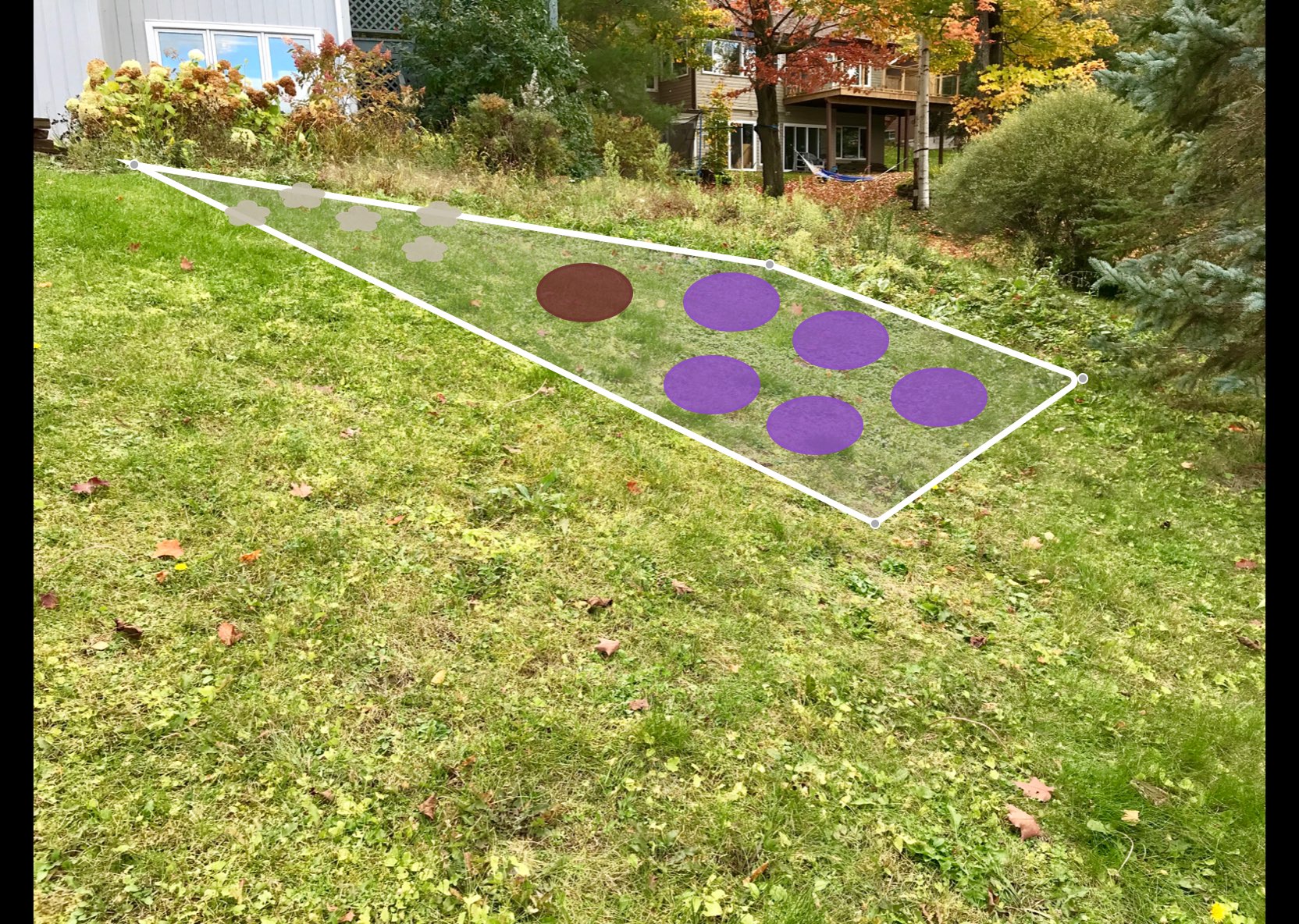
Compartment E
Naturalization Area
Wildflower Farm - Eco-Lawn pH: basic
pH: basic Depth: potted
Depth: potted-
 Moisture: normal
Moisture: normal -
 Soil Type: sandy, loamy
Soil Type: sandy, loamy -
 Light conditions: partial sun
Light conditions: partial sun
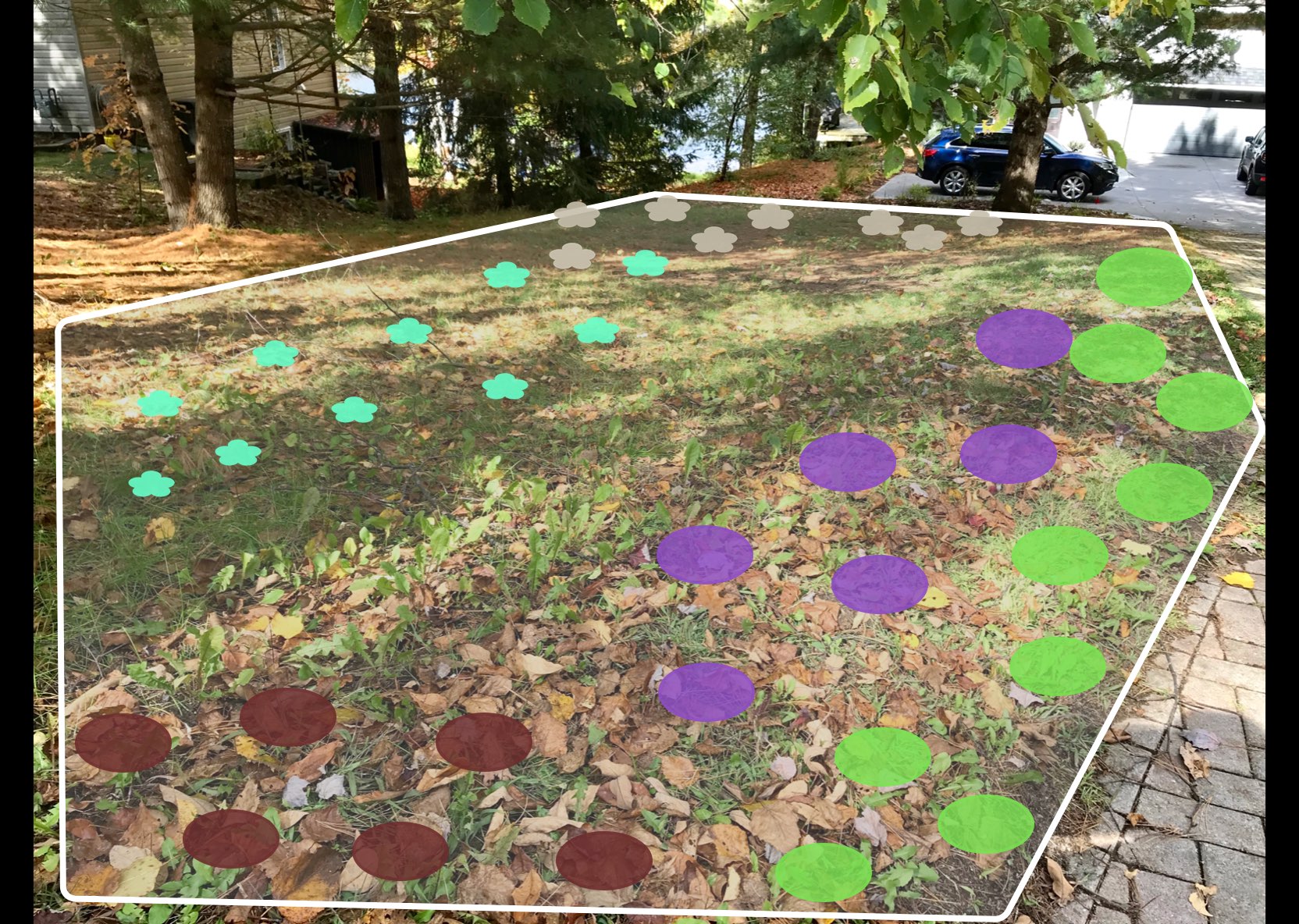
Schedule B
Financial Summary
Project by: The District Municipality of Muskoka
Shoreline Re-Naturalization Starter Kit includes: free site visit, customized re-naturalization planting plan for your shoreline property, native plants including free bare root (small) and potted (large) plants and wildflowers, coconut fibre pads to deter grass from growing around new plantings, tree guards for all deciduous trees, mulch for your wildflowers, Plant Care Guide with instructions on how to take care of your new plants, Habitat Creation Guide and a Wildflower Garden Guide.
Our planting plans are created onsite with you and provide detailed information and plans to re-naturalize your shoreline property. We take photos of areas for planting and overlay native plants that are well suited to your property based on site conditions such as soil type and sunlight availability.
We will work with you to create a plan that works for you including options for low growing plants in areas where views are important.
| Item | Quantity | Cost/Item | Subtotal |
|---|---|---|---|
| Starter Kit fee | $300 | ||
| Free potted plants | 20 | $0 | $0 |
| Paid potted plants | 51 | 12.00 | 612.00 |
| Free bareroot plants | 0 | $0 | $0 |
| Free wildflowers | 30 | $0 | $0 |
| Paid wildflowers | 40 | 6.00 | 240.00 |
| Total costs | 1152.00 |
Schedule C
Project Agreement
Stewardship Agreement
Please indicate your agreement to this proposed plan by signing the following Stewardship Agreement and submitting it, along with your financial contribution, to:
The District Municipality of Muskoka
70 Pine Street
Bracebridge, Ontario
P1L 1N3
Plant Availability
Please note that plant species may need to be changed based on plant stock availability at the time of ordering.
Project Completion
Upon receiving your signed stewardship agreement and financial contribution, a date will be booked for you to pick up your Natural Edge Kit. The District Municipality of Muskoka will supply all plants and materials. If you are paying for the planting to be completed for you, a date will be arranged for The District Municipality of Muskoka to plant your shoreline, bringing the plants and materials with them. If there are particular dates that you would prefer, we will do our best to accommodate your requests.
The Natural Edge Stewardship Agreement with The District Municipality of Muskoka
Agreement made this 6th Day of the Month of October in the Year 2020.
BETWEEN Rob Belsey 500 Bayshore Boulevard Ontario (Hereinafter called the OWNERS)
AND The District Municipality of Muskoka 70 Pine Street Bracebridge, Ontario P1L 1N3 (Hereinafter called DMM)
WHEREAS the Owners and DMM have met and discussed plans for shoreline naturalization on the specified area(s) in Schedule A existing on the Owners’ land;
WHEREAS the Owners indicate approval of the project as proposed; and
WHEREAS the project is, or will be for the benefit of the Owners and others;
NOW THEREFORE THE PARTIES AGREE AS FOLLOWS:
1. This Agreement shall be in effect for a period of 5 years, commencing with the date of this Agreement.
2. The Owners and DMM agree that the areas where the work is to be performed is as described in Schedule A.
3. The Owners agree to pick up their Natural Edge Starter Kit from DMM’s office and plant their shoreline within two days of receipt. The Owners will provide “after” photos of the work completed to be used for reporting purposes. If the Owners wish to have the planting completed for them, then DMM or it’s contractors, employees and agents will complete the planting at cost, as indicated in Schedule B.
4. If the planting is to be completed by DMM, then the Owners grant DMM, its contractors, employees and agents, the right to enter the property to perform the work agreed upon as outlined in Schedule A. In addition, DMM, its contractors, employees and agents may inspect the work performed for the purposes of monitoring the project and survival assessment, with prior agreement with Owners for date and time of inspection.
5. The Owners agree to contribute the “Landowner contribution” and pay the costs indicated in Schedule B.
6. In instances where the Owners are to pay DMM for work to be performed (outlined in Schedule A), the Owners agree to provide payments to DMM prior to the commencement of that operation. Failure of payment shall constitute a breach of this Agreement and the Owners agree that this Agreement will be terminated and thereupon the Owners agree to pay DMM the estimated costs of the operations of the project completed to date, if any.
7. The Owners agree, if necessary, to perform a reasonable amount of maintenance, which is described in the Native Plant Care Guide, available at naturaledge.watersheds.ca.
8. If a contractor is required to perform the work outlined in Schedule A, then the contractor carrying out the work on the land described will be required to take out and furnish evidence of a comprehensive policy of public liability and property damage coverage. The contractor and their workers will be required to be in good standing with the Workplace Safety and Insurance Board (WSIB) prior to performing the work.
9. The Owners agree not to remove, destroy or alter the project without prior consultation and approval of DMM. Pruning and trimming planted nursery stock, or adding replacement native nursery stock is exempt.
10. The Owners agree not to mow the planted area.
11. The Owners do acknowledge that DMM, its contractors, employees and agents, having performed said works, are not under further obligation with respect to survival of nursery stock, inspection, or maintenance.
12. The Owners, in the absence of negligence, hereby remise, release and forever discharge DMM, its contractors, employees and agents from all claims and demands for injuries, including death, loss, damages and costs in any way related to or connected with installation and maintenance of the work described or resulting from any deleterious effects of the work to the land or to the lands and buildings thereon retained by the Owners.
IN WITNESS WHEREOF the parties have agreed to the contents of this plan; SIGNED:
About this program
About The District Municipality of Muskoka
The District of Muskoka is an upper-tier municipality that has monitored water quality in Muskoka area lakes since 1980. Since 2002, the Muskoka Water Strategy has provided integrated and strategic initiatives for the protection of Muskoka's water resources. The purpose of the strategy is to guide and minimize the impact of human activities on water resources; ensure human and environmental health; and preserve the quality of life in Muskoka.
This program was created by Watersheds Canada
We believe that every person has the right to access clean and healthy lakes and rivers in Canada. At Watersheds Canada, we work to keep these precious places naturally clean and healthy for people and wildlife to continue using for years to come. We love working with others to meet the needs of local communities, whether you’re a concerned citizen, a landowner, a lake association looking for help, or a coalition of groups interested in activating your local community.

